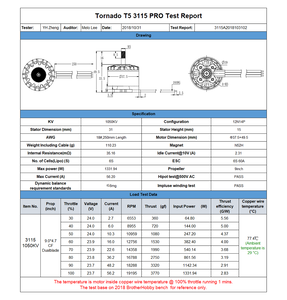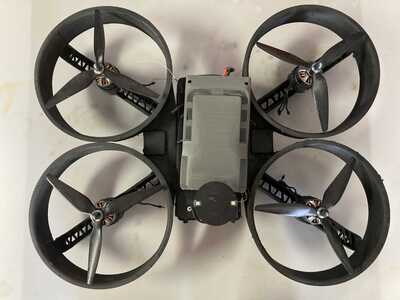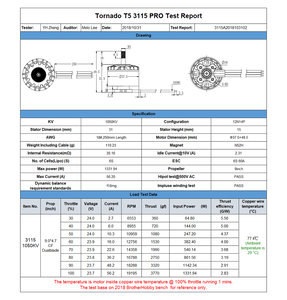Terms And Conditions Please Read and Accept the Daytona Drone Club Terms to participate in the Forum
Motor Sizing
The Size of brushless motors is indicated by a 4-digit number – AABB. “AA” is the stator width, while “BB” is the stator height or stator diameter, both in mm (millimetre).
Example,
XING 2208 1800KV Brushless Motor 6S for QAV FPV Racing Drone Quadcopter
Has a stator with a diameter of about 22mm and with a height of about 08mm.
Taller stator = more power at higher RPM (read "power" below)
Wide stator the more torque at lower RPM
KV determines what propeller you can use with a motor
KV value of a motor indicates the speed with which the motor would rotate when you apply one volt across its windings. It is determined by the number of copper wire winding in the motor stator, and the magnetic strength of the magnets.
Basics:
Higher number of winds decreases the KV of the motor.
Lower number of winds increases the KV of the motor. Less windings means less resistance--more current flow---higher RPM
"lower the KV the larger Prop"
The lower the KV the larger the prop that it can spin and the vice versa.
:Reasoning #1 You cant generate more lift by putting a larger propeller on the higher KV motor because the torque requirements will push the motor beyond its rated power limits and overheat.
Note -The KV is by no means an indicator of the power output of the motor, higher KV motors are not necessarily more powerful than lower KV motors.
Power is determined by the wattage of the motor, or the amount of amps (A) it can withstand at a particular voltage (V).
Power = Voltage X Current
500W = 12V X 42A
500W = 20V X 25A
Example:
BR2205 2600kv motors can run 5x4 inch props
BR2212 1000kv motors can run 10x4.5 inch props
This is the specifications for the first motor selection for drone ser 1
The specs breakdown will be analized to determine the prop and performance of the motors with 6s battery
Hobbywing XRotor 40A ESC 2-6S Wire Leaded for 550 650 Quadcopter Drone
The decision was made to select an inexpensive ESC that would work right out of the box. (hopefully)
The objective is to try different motor and prop configurations for the Printed commercial drone build ser #1 and to build some data
The many factors in the spec sheets will be analyzed and performance recorded so we can get the most efficient operation for the different configurations we will be working with.
Not alot of fluff here but hoping for reliability and longevity (12 bucks each, what would you expect)
- Brand: Hobbywing
- Model: XRotor 40A(Asian Version A)
- Continous current: 40A
- Burst current: 60A
- BEC: NO
- Power supply: 2-6S LiPo battery
- Output Connectors: 3.5 Gold Connector(Female)
- Suit for: 550 650 RC drone quadcopter
- Quantity: 1
- Size: 65 * 25 * 7mm/pcs
- Weight: 44g/pcs
This is an information post on the current build ver1 of 3d printed drone designed inhouse. A couple specific requirements were established number 1 being had to be 3d printed.
A couple frames were developed, one large and one not so. Primarily the mission is a seeker build using A computer package developed in the US. The number 1 build uses a standard pixhawk computer, pixracer pro
with a PM07 distribution and TEKKA 32 ESC. This post is about the motors and blade configuration
The motors I am setting up are Brotherhobby Tornado 3115 1050kv. I have some off the ground telemetry I hope to provide from the first flight
The blades are 3 blade 9in HQProp 4pcs HQ Macroquad Prop 9X5X3 Tri-Blade Propeller 9 inch
The basic math is 70% throttle 23v, 22amp,14500 rpm, thrust 2000 gf , 540w input , 3.68 thrust efficancy
https://www.ecalc.ch/xcoptercalc.php
KV motor estimate This is another motor manufacture estimate to lift ver1 The current motors can do this at 70%
THRUST REQUIREMENT CALCULATIONS:
| Baseline Thrust Requirement | 2,000 g |
| 4.0% Efficiency Loss For Environmental Effects | 80 g |
| Optimal Throttle Percentage (Hover Range) | 45.0% to 55.0% |
| Total Thrust Requirement | 2,080 g |
Overall the unit should fly but for limited time around 16 min. Losing some weight like 6oz could help bring it to 20 min which is the low side of our expectations but flying will be the ultimate test
Ok to bring this up to date. the tornado motors just got so hot they melted the motor mount. 1 of the esc was also smoked. What was supposed to be a good setup just didn't cut it. The drone flew but
the motors over heated . I went to the brotherhobby r7 and flew pretty good. I recorded 3 flights and things were getting pretty stable then I planted it.
Thats ver1 with the tornados (fail)
ver 2 with r7 stable
ver 3 with r7 stable getting conditioned
ver 4 T-motor 4014-11 kv330 mistake purchase. Things couldn't spin the blades fast enough to get flight
replaced with r7 and installed the blade guards. troubles with establishing stable flight
The R7 is 490 KV and the blades are 9in 3blade. The numbers from the calculator are not that good as far as flight time so will be considering options for the next motor setup
I'm thinking in the 30 range at 900kv, funny that's the tornado. Testing will continue
Reviewing and motor selection Balance between rpm and torque when picking motor and propeller
Points:
Motors should be able to provide twice as much thrust as the total weight of the quad
Brushless motors are typically categorized by a four-digit number – such as **##. where as the “**” numbers are the stator width and “##” is the stator height.
The wider and taller the motor is, the larger the numbers are and the more torque it can produce.
KV is the theoretical increase of motor rpm (rotation per minute) when the voltage goes up by 1 volt without load.
4S Lipo Battery 14.8V 6S LiPo batterie 22.2v
high KV motors with large propellers, will draw a lot of current and produced an excessive amount of heat when trying to spin the larger props fast.
Higher KV motors would turn the propeller quicker with less torque, and lower KV motors create higher torque with slower rotation.
lets look at some examples
conmmercial hex drone (orange) 1860g/ 4.1lbs (w/o payload)
4S 6200mAh LiPo
720KV
3215 motor physical size (OD)
That's
4s battery x 720kv
14.8v x 720 = 10,656 rpm
so if we take the drone weight and divide it by 6 motors we get the thrust required, thats 2 times the result to be applied
1860 / 6 = 310 thrust require times 2 = 610 thrust needed by each motor
lets see if we get there in this example
But results are not always what's predicted
we setup brotherhobby tornado 3115 1050kv motors and ran them with 6s batteries and melted the drone
lets see how we got there
22.2v x 1050kv = 23310 RPM
so with the 3blade 9x5x3 prop the motor got to hot (Reasoning #1)
What's the solution or next test?
We used a ESC that might have been to small and that might have been the issue. the motor spec calls for 60amp esc although this motor should lift the drone at 40% power no problem, but we fried an ESC. Did the motor get hot because the esc couldn't power it or did the motor and esc get hot because the prop was to big?







